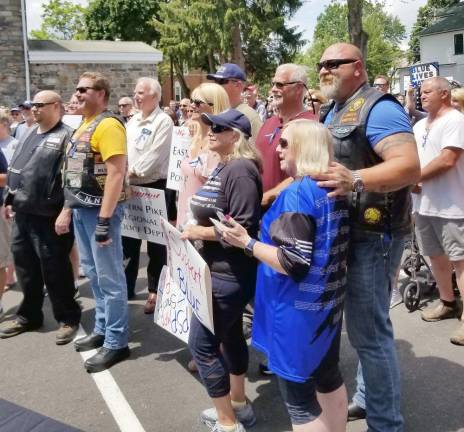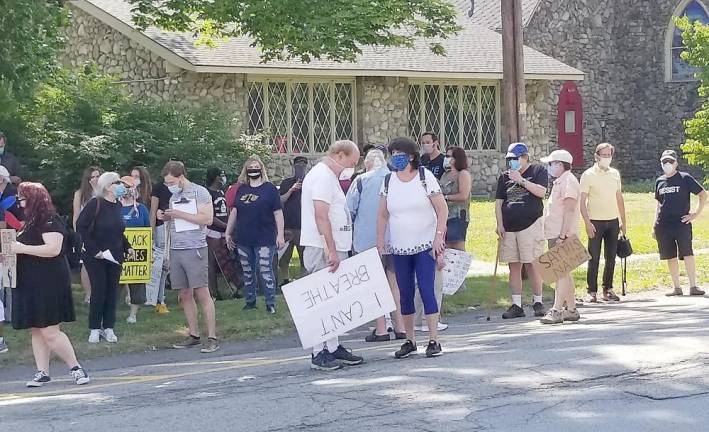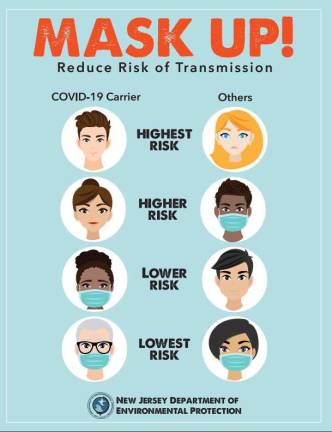A little scrap of fabric, a growing division
Coronavirus. On both sides of the mask question, emotions run high.



Most people have by now made a mask part of their daily uniform, out of a sense of civic duty, a requirement of their job, a layer of protection against the virus, or some combination of the above. Others are not masking up when they’re out and about, preferring to risk dirty looks than claustrophobia, difficulty breathing, or a feeling of dehumanization when they’re skeptical that cloth masks even protect from the virus to begin with.
“I think wearing a mask should be a choice, personally,” said Lisa Mitchell, owner of Down2Earth, a health food store in Florida, N.Y. If you’re coughing, sneezing, or feverish, then by all means stay home or wear a mask, she said, or if you’re vulnerable or have elderly parents at home. But for young, healthy people “to act as if they’re contagious and diseased when the reality is it’s very unlikely you can pass it if you’re asymptomatic – it’s unreasonable,” she said.
Medical experts, however, are in remarkable agreement about the prevalence of asymptomatic spread. “Whether people have symptoms or not, they carry the same amount of virus inside them,” said Gigi Gronvall, an immunologist and senior scholar at the Johns Hopkins Center for Health Security and an associate professor at the Johns Hopkins Bloomberg School of Public Health. “This suggests that transmission is possible equally from both asymptomatic patients and noticeably sick patients.”
Still, there are those who prefer Mitchell’s approach. “I will not live in fear of a virus,” she said. “I will be cautious, aware, considerate, conscious, but I will not be fearful. Humans have been fighting and overcoming viruses for millennia.” She’ll cover her face to dash into a store, but no longer does she duck into a bandanna around her neck every time a customer walks in her door. “I just wish people would gain the confidence to live in a little bit less fear,” she said.
Taking one for the team
The Centers for Disease Control and Prevention reversed its initial advice in early May to recommend that people “wear cloth face coverings in public settings where other social distancing measures are difficult to maintain, such as grocery stores, pharmacies, and gas stations” – not so much for you, but for everyone else. A cloth mask, as opposed to a respirator, is not designed to keep out particles as small as viruses, though it could help deflect spray from a cough or sneeze. “It may keep the wearer from spreading the virus to others,” says the CDC. It’s a selfless act, in other words, that helps keep your droplets to yourself -- taking one for the team.
“Wearing a mask is like doing a service to your community,” said Dr. Vanitha Rodrigues, chief of radiology at Newton Medical Center. “It’s not for you.”
As for healthy people who say they can’t breathe in a mask, Rodrigues pulls no punches: “It’s total bullshit.” There’s no scientific basis for mask-wearing being detrimental for anyone over age two, she said. “Neurosurgeons operate for seven hours straight wearing a mask. You don’t pass out and die after the surgery. I have some of my friends who say they get claustrophobic, but I don’t believe them. They just don’t want to try.”
In Asian countries like Hong Kong, people mask up at the first sign of an outbreak, said Rodrigues. But we don’t do that in America – until now. “This virus is unique,” said Rodrigues. So, too, must be our response.
When will it be safe to take our masks off? “Because this is kind of a lethal and deadly virus, I would do it until we find a vaccine – a vaccine that works,” she said. “If we can just do it for a little longer ‘til we cross this tide, ‘til we get a vaccine,” we may be able to avoid a second wave. Rodrigues worked with the Sparta Public Library and the Pope John High School robotics team to 3-D print face shields for medical workers during the height of the pandemic.
Achieving herd immunity is not the path we want to take, she said. We’re barely at 20 percent in New York and New Jersey after all we’ve been through, and we’d need to get to about three times that. The first wave was so terrible, the least we can do is use protective measures to prevent a recurrence of what happened two months ago, she said. “It’s like wearing a condom while having sex – why would you not do it?” she said.
Sign of weakness? Or badge of responsibility?
On both sides, feelings run strong. Consistent guidance, less so. President Donald Trump eschews masks and told supporters at his recent rally to do whatever they want. Vice President Mike Pence goes back and forth. Mask protocol varies wildly state by state, including the age at which children should cover their faces: 2 in New York, New Jersey, and Pennsylvania, 12 in Delaware.
From the beginning of the pandemic, there has been a gap in the way conservatives and liberals perceive and react to the virus: how strictly we adhere to precautionary measures like social distancing, masking up, and staying home. Even as mask-wearing has gone up across the board, the partisan gap has widened, with nearly all Democrats reporting they’d worn a mask the week ending June 14, versus less than 70% of Republicans, according to a Gallup poll.
Entangled in political bickering, a nuanced and serious health question has been co-opted into an ideological bludgeon -- badge of communal responsibility, or scarlet letter pinned on the weak? That kind of thinking may or may not have any basis in the reality of the actual human making the decision. Now, instead of the casual banter that used to fill the time on line at the grocery store, we stand six feet apart, silently judging each other.
“I’m being seen as selfish and very self-centered and not caring about anyone else or the collective good if I go out without a mask,” said Anna Lopez, a natural parenting educator in Warwick, N.Y. “I’m starting to hear a lot more talk about it’s for the community. It’s not to protect you, it’s for vulnerable people. It’s not about your own personal health or your own freedom or your own comfort, anything in relation to you. It’s just about others.”
Early on in the pandemic, wearing a mask for a 15-minute grocery run made Lopez so lightheaded that she was concerned about driving home. After that episode, her husband took over the big-store shopping. Lopez suffers from mild allergies but is otherwise healthy. So what about her friend, a nurse who has asthma? What about the people behind the register, stocking shelves, the vast army of workers including waiters, construction workers, and medical personnel, who are required to wear a mask for four-plus hours at a stretch? “The mandate that everyone wears that, regardless of what they’re doing and what kind of face covering they have, I think that’s medically reckless and dangerous,” said Lopez.
Lopez has put on a bandanna for a farmers market trip, but otherwise does not wear a mask, which she doesn’t believe provides any more protection than the typical courtesy of coughing into your elbow, anyway. She recently got yelled at by a store owner, she said, for approaching a liquor store mask-less. “I completely respect that if that’s how she wants to run her store, I’m not going to barge into her store, mask-free, to buy something,” she said.
A lack of respect on both sides saddens her, including from the emerging, aggressively strident anti-mask contingent. “I think we all have our personal freedoms,” she said. “If they’re uncomfortable with it, they don’t need to be close to me. I’m not walking up to people and coughing on them or breathing down their necks. They’re free to keep their distance. I do believe that.”
Growing up with masks
The one time Lopez took her five-year-old to the store, an activity he used to love, it scared him to see all the masked people. The masked people, too, seem changed. “Everyone seems to be afraid of each other. It’s beyond even the avoidance of six feet,” she said. “It’s almost as if people are afraid to make eye contact, or just engage in any way: in a conversation, a smile or anything.”
Lopez, a mother of three, believes that living in a masked society is going to have a lingering “fear effect” on children. “Masks are definitely associated with fear: fear of others, fear of diseases. I think it definitely makes kids more on edge,” she said. “And also just the way we communicate, body language, facial expressions, everyone’s just a walking piece of fabric with eyes. It really I think limits communication and connection, especially for the younger kids.”
The debate is only going to intensify as schools figure out how to reopen this fall. Masking students is a regular feature of the plans being discussed, while recess, lunch, music, gym and bathrooms remain big question marks. Mitchell, of Down2Earth, is considering private school and home school for her two high school-aged boys. “I can’t subject my kids to that type of inhuman environment eight hours a day, five days a week,” she said.
“It’s so hard for them to put on a mask,” said Dr. Rodrigues, whose kids attend Pope John high school. Strange as it is to fathom, masking students is more realistic than social distancing. “Forget being six feet away, you can’t do that in schools,” she said. “So you have to wear a mask to prevent the transmission.”
No one’s thrilled about it. “There’s so many things we’ve sacrificed, right, because of this virus. So many, many, many things,” said Rodrigues. “All I can say is, it’s going to be temporary.”
“There’s so many things we’ve sacrificed, right, because of this virus. So many, many, many things. All I can say is, it’s going to be temporary.” --Vanitha Rodrigues, chief of radiology at Newton Medical Center